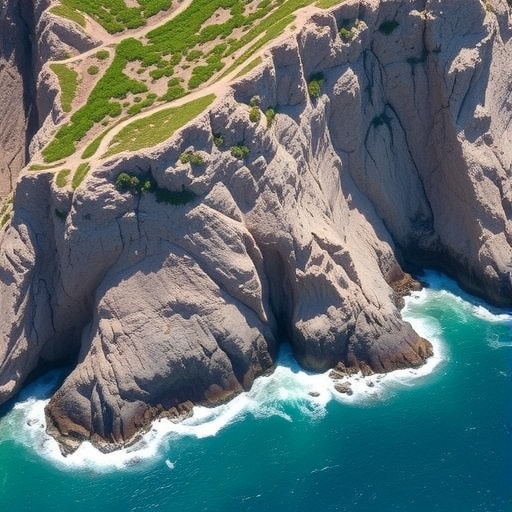In a groundbreaking study published in Environmental Earth Sciences, researchers Pereira, Monterrubio, and Bloise delve deep into the complex geological processes that underlie the transformation of serpentinite rock into talcose formations. Their pilot study, centered on the ultramafic massif of Cabo Ortegal in northwest Spain, uncovers pivotal mineralogical and structural shifts with far-reaching implications for understanding metamorphic rock evolution and regional geology.
Serpentinite, a rock formed from the hydration and metamorphic transformation of ultramafic rocks rich in olivine and pyroxenes, often serves as a window into the dynamic geochemical processes within the Earth’s crust. This study focuses explicitly on the pathways by which serpentinite progressively alters into talcose rocks—characterized primarily by the mineral talc—under specific pressure, temperature, and fluid conditions prevalent in the Cabo Ortegal massif. These processes not only redefine the physical properties of the rocks but also affect their geomechanical stability and broader tectonic significance.
The ultramafic massif of Cabo Ortegal is particularly rich in serpentinized rocks, making it an exceptional natural laboratory for exploring metamorphic transformations. The authors meticulously documented how pervasive metasomatic reactions facilitate the replacement of serpentine minerals by talc and other magnesium-rich phases. By utilizing an array of petrographic, geochemical, and mineralogical investigative techniques, the research elucidates the subtle and progressive chemical exchanges and recrystallization pathways that govern this transformation.
One of the critical insights from the study concerns the role of fluid-rock interactions during metamorphism. The infiltration of magnesium-bearing aqueous fluids into serpentinite initiates hydrothermal reactions that systematically replace serpentine with talc through dehydration and recrystallization. This mineralogical transition is marked by distinct microstructural changes, including the development of foliation and the reorganization of the crystal lattice, which collectively influence the mechanical behavior of the rock mass.
Moreover, the transformation process has significant ramifications for regional tectonics. Talcose rocks exhibit markedly different rheological properties compared to their serpentinite precursors, influencing fault mechanics and slip behavior in the crust. The weakening effect imparted by talc can facilitate localized deformation zones, potentially impacting seismic activity patterns within and adjacent to ultramafic massif regions like Cabo Ortegal.
This study also sheds light on the broader geochemical cycles relating to magnesium mobility and carbon sequestration. As serpentinites alter to talc-rich assemblages, elements such as magnesium are redistributed, potentially influencing the capacity of these rocks to trap and store carbon dioxide through mineral carbonation processes. Understanding these transformations at a detailed scale paves the way for better modeling of natural carbon sinks and their viability for mitigating climate change.
Another fascinating dimension of the Cabo Ortegal massif is the documented variability in the intensity of talcose formation across different structural domains. The researchers mapped zones where talcose rocks dominate and correlated these distributions with factors such as fluid pathways, temperature gradients, and rock permeability. Such spatial heterogeneity underscores the complexity of metamorphic processes and highlights the necessity of integrating geological mapping with microscale analytical tools.
Furthermore, the implications for economic geology are not negligible. Talcose formations possess distinct physical and chemical properties that could influence mineral extraction strategies. The study postulates that identifying talc-rich zones within serpentinite bodies can guide exploration efforts for talc deposits, which have numerous industrial applications ranging from ceramics to cosmetics.
Innovative analytical methodologies were central to this research. The team employed advanced microprobe analyses, X-ray diffraction techniques, and electron backscatter diffraction to characterize the mineralogical transitions with high precision. These methods allowed for the quantification of mineral phases and crystallographic orientations that reveal deformation patterns and the kinetics of serpentine-to-talc conversion.
In addition to laboratory analyses, the research incorporated field observations and mapping that contextualize mineralogical data within the structural framework of the massif. This integration of field and lab data strengthens the reliability of interpretations and promotes a holistic understanding of metamorphic processes in natural settings.
The structural consequences of talc formation are profound. Talcose rocks characterized by their platy, lubricating mineral structure tend to localize shear zones, and their presence can dictate the style and distribution of deformation in ultramafic complexes. Recognizing these rock units geophysically could enhance seismic risk assessment and resource management in ultramafic terrains.
Intriguingly, the study also addresses the temporal aspects of these transformations. By constraining the metamorphic timeline through radiometric dating and cross-cutting relationships, the researchers offer a window into the duration and episodicity of hydrothermal alteration events. Such chronological insights deepen our understanding of tectonic and metamorphic processes operating over millions of years.
This pilot investigation paves the way for future, more extensive studies aiming to unravel the complexities of serpentinite alteration globally. While focused on Cabo Ortegal, the findings hold relevance for other ultramafic terrains worldwide, where similar serpentine-to-talc transformations may occur under comparable geological settings.
Ultimately, the work by Pereira and colleagues enriches our comprehension of how fluid-mediated metamorphic reactions can profoundly alter both the mineralogical makeup and geomechanical attributes of ultramafic complexes. Such insights hold promise for advancing tectonic modeling, resource exploration, and our grasp of Earth’s dynamic systems, cementing the importance of integrative geological research.
Subject of Research: The mineralogical and geochemical transformation from serpentinite to talcose rocks in ultramafic massifs, specifically within the Cabo Ortegal massif in NW Spain, and the broader geological and tectonic implications of these processes.
Article Title: The transformation from serpentinite to talcose rocks and its consequences. A pilot study in Cabo Ortegal, an ultramafic Massif in NW Spain.
Article References:
Pereira, D., Monterrubio, S. & Bloise, A. The transformation from serpentinite to talcose rocks and its consequences. A pilot study in Cabo Ortegal, an ultramafic Massif in NW Spain. Environ Earth Sci 84, 587 (2025). https://doi.org/10.1007/s12665-025-12598-2
Image Credits: AI Generated




